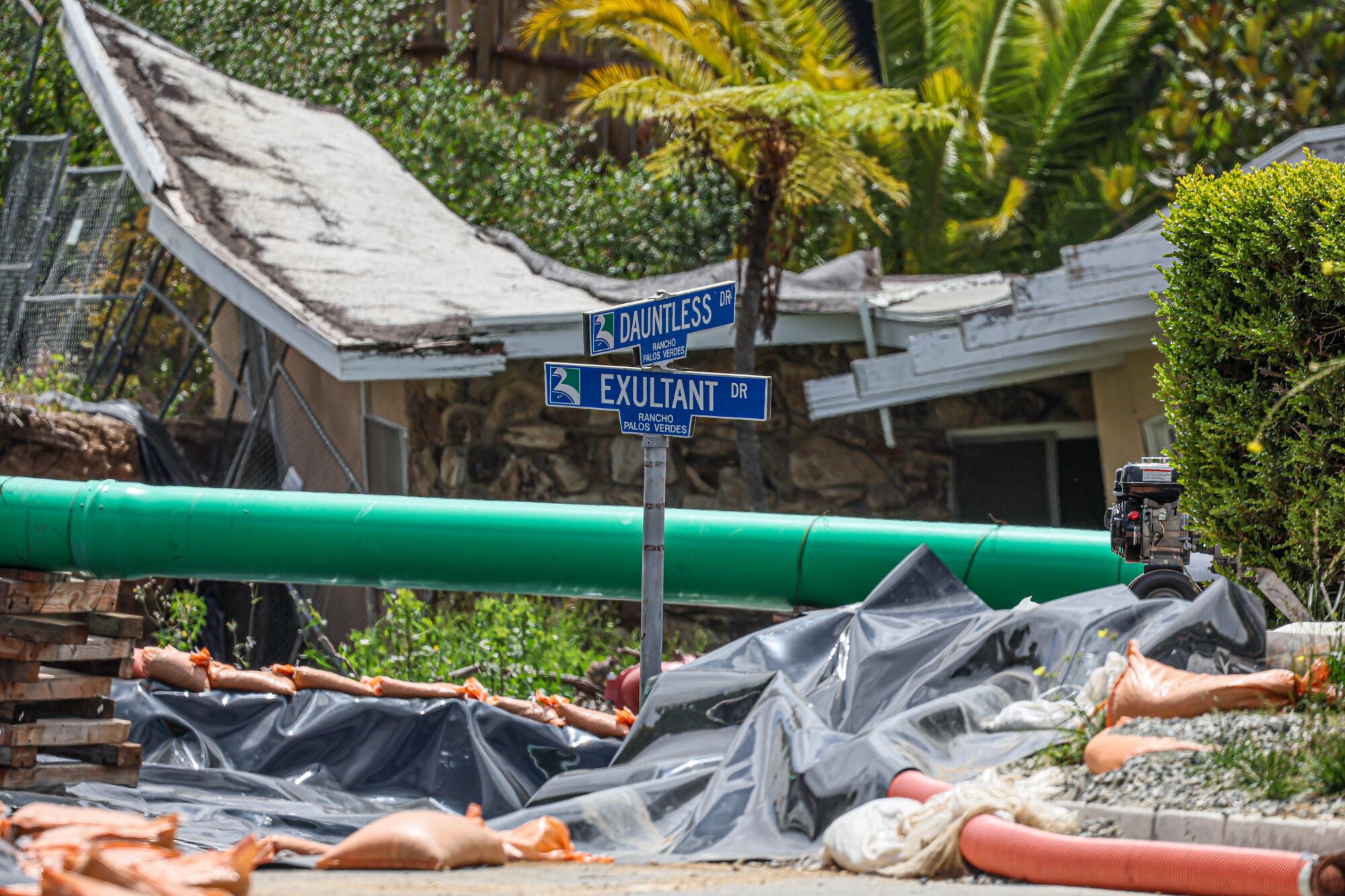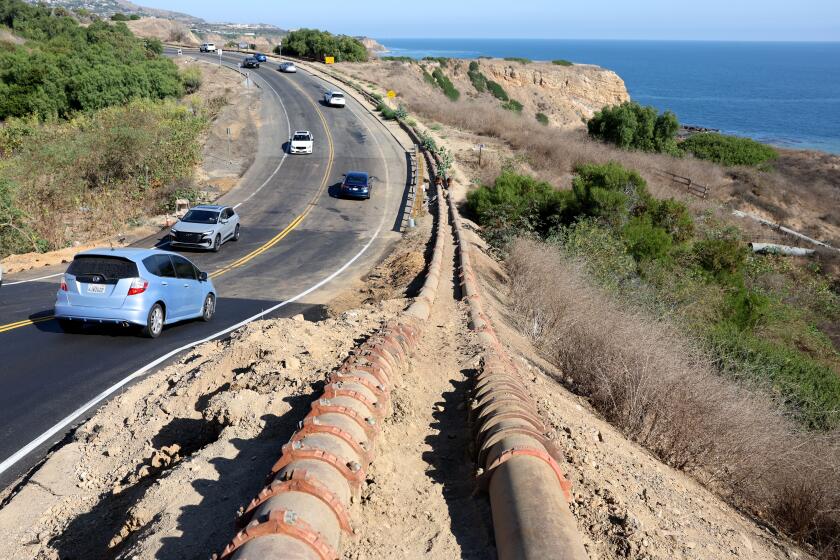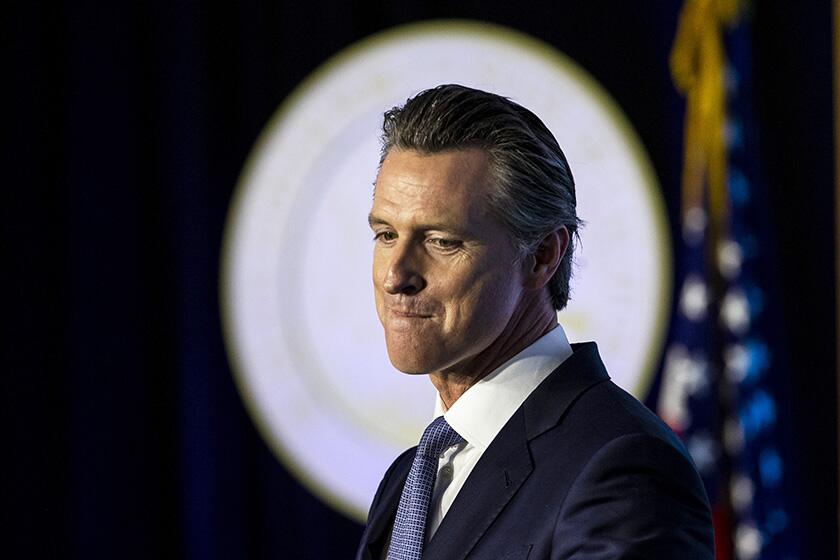
- Share via
For the last 18 months, the city of Rancho Palos Verdes has been struggling to address a worsening local emergency — the dramatic expansion of an ancient landslide zone that has torn homes apart, buckled roadways and halted utility services.
Triggered by a succession of heavy winter rains in 2023 and 2024, the ongoing land movement has upended the lives of residents and cast the city into financial uncertainty. Without significant outside aid, officials say they expect to spend about $37 million this fiscal year on emergency landslide mitigation — a sum nearly equal to the city’s annual operating budget.
Now, to make matters worse, the Trump administration has announced that it will cease funding the Federal Emergency Management Agency’s Building Resilient Infrastructure and Communities grants — a major pot of money the city hoped to use to finance a long-term prevention and stabilization plan.
“The BRIC program was yet another example of a wasteful and ineffective FEMA program,” read the administration announcement. “It was more concerned with political agendas than helping Americans affected by natural disasters.”
Rancho Palos Verdes officials may impose a toll on Palos Verdes Drive South to help cover the cost of damage caused by an ongoing landslide.
For the city of Rancho Palos Verdes, the action amounts to the likely loss of $16 million for stabilization work. It also marks a striking reversal in federal support for local slide mitigation efforts.

In September 2024, a campaigning Trump visited his nearby Trump National Golf Club to say that government needed to do more to help residents in the slide area. “The mountain is moving and it could be stopped, but they need some help from the government. So, I hope they get the help,” Trump said.
Last week, city officials again extended a local emergency declaration as the crisis continues to pose unprecedented strain on city finances.
“We are running out of money quickly,” Rancho Palos Verdes Mayor Dave Bradley said at a recent City Council meeting. “We are dramatically coming to the end of our rope to be able to [continue landslide mitigation efforts]. ... We are spending major percentages on our total budget on this one issue.”
The majority of those allocated funds have gone toward a collection of new underground “de-watering” wells, which pump out the groundwater that lubricates landslide slip planes — a strategy that geologists have credited with helping to ease the movement in recent months.
Millions of dollars have also gone toward repeated repairs to Palos Verdes Drive South — which continues to crack and shift — as well as efforts to fill fissures, improve drainage and maintain important infrastructure, such as sewer and power lines.
While the city isn’t yet facing a major budget shortfall, its reserve funds have quickly dwindled over the last two years. By next fiscal year — which begins in July — the city expects to have only $3.5 million in unallocated capital improvement reserves, down from $35 million three years ago, according to city data. And while landslides have been the most pressing concern of late, city officials say they now face an estimated $80 million in other capital projects.
“Without a doubt, we need outside help for this landslide,” said Ramzi Awwad, the city’s public works director. He said the city is working to find and apply for other federal and state funding sources, but has run into roadblocks because landslides are not typically included within most disaster or emergency response frameworks.
“This is a disaster ... very much exacerbated by severe weather and severe climate change,” Bradley recently testified before the California Assembly Committee on Emergency Management. He called the growing price tag for necessary response “unsustainable.”
Many areas of the Rancho Palos Verdes landslide complex — which covers more than 700 acres and includes about 400 homes — are still moving as much as 1.5 feet a month, damaging property and infrastructure, according to the city. Other sections that shifted several inches a week at the peak of movement in August 2024 have slowed or completely halted. City officials attribute those improvements to the ongoing mitigation projects as well as a much drier winter — but they say more work is needed to keep the area safe and accessible.
Officials argue the loss of FEMA funding could stymie long-term slide prevention efforts that were in the works for years before land movement drastically accelerated last year.
The Portuguese Bend Landslide Remediation Project, which calls for the installation of a series of water pumps called hydraugers, as well as other measures to keep water from entering the ground, was initially awarded a $23-million FEMA BRIC grant in 2023, Awwad said. The grant was later reduced to $16 million.
The project is separate from the city’s ongoing emergency response, but key to long-term stability in the area, Awwad said.
Mass firings at the National Weather Service have started to affect local offices across the nation, with some locations limiting operations. And it could just be the beginning with further budget cuts looming.
Rancho Palos Verdes officials dispute the administration’s assertion that the BRIC grant program is “wasteful and ineffective.” Instead, they say it represented a lifeline for a small city that has long dealt with landslides.
For decades, the city’s most dramatic landslide — the Portuguese Bend slide — has moved as much as 8.5 feet a year, or approximately an inch or two per week. Last summer, it was moving about a foot a week. Other nearby landslides, including Abalone Cove and Klondike Canyon, also saw dramatic acceleration last year, but those areas are not a part of the long-term stabilization plan.

“Losing the BRIC funding will jeopardize the city’s ability to implement long-term efforts to slow the Portuguese Bend landslide and prevent the kind of emergency we are experiencing now from happening again,” Megan Barnes, a city spokesperson, said.
Because BRIC grants were earmarked for preventive measures, the city was unable to use the money for its emergency response. But in recent weeks, the city completed the first phase of the long-term project — planning, engineering and final designs — after FEMA approved $2.3 million for that initial work.
Officials say the city has yet to receive that portion of the funding, and it is now unclear whether it ever will.
“We are still seeking clarification on the next steps for what, if any, portion of the BRIC grant may be available,” Barnes said. “We continue to strongly urge our federal, state and county partners to recognize the urgency of this situation and continue to support the city in protecting our residents and vital infrastructure.”
Awwad said it’s not just the local residents who benefit from such stabilization efforts; it also helps the thousands of motorists who use Palos Verdes Drive South and thousands more residents who rely on the county-run sewer line that runs alongside the road.
“This is a regional issue,” Awwad said.
Barnes said the city is considering applying to FEMA’s Hazard Mitigation Grant Program for the project, but securing state or federal funding for stabilization projects has been a challenge.
After the Biden administration declared the 2023-2024 winter storms a federal disaster, the city applied to FEMA for over $60 million in disaster reimbursements, linking its landslide mitigation work to the heavy rainfall. But FEMA officials rejected almost all of the city’s request.
FEMA has allocated $42 million to buy out homeowners in landslide-ravaged Rancho Palos Verdes. The program will turn the properties into open space in an effort to avoid future disasters.
The city has appealed that decision, but it seems unlikely federal officials will reverse course. In a recent letter to FEMA about the appeal, the California Governor’s Office of Emergency Services recommended the appeal not be granted because the landslides “were unstable prior to disaster” and therefore not a “direct result of the declared disaster.”
“Cal OES agrees with [the city] that the winter storms… may have greatly accelerated the sliding,” the letter said. “However … the pre-existing instability dating back to 2018 makes that work ineligible per FEMA policy. “
The most significant outside funding the city has received has come from Los Angeles County. Supervisor Janice Hahn secured $5 million for the landslide response — more than $2 million of which has been distributed to homeowners for direct assistance through $10,000 payments. The county’s flood control district also allocated the city $2 million to help cover costs preparing for the rainy season.
In 2023, the city also received $2 million from Congress after U.S. Sen. Dianne Feinstein (D-Calif.) helped secure the funds for landslide remediation.
The city’s most dramatic financial support — if it comes through — would be a $42-million buyout program that was awarded last year by FEMA. With that money, city officials expect a buyout of 23 homes in the landslide zone, 15 of which have been red-tagged, or deemed unlivable. FEMA has yet to allocate those funds, Barnes said, but even if it does, none of the money would go toward slide mitigation or prevention.
The California Coastal Commission has ordered Sable Offshore Corp. to cease and desist in its bid to revive oil drilling off the coast of Santa Barbara.
In the face of such difficulties, city officials have thrown their support behind a bill that could change how the state classifies emergencies.
Assemblymember Al Muratsuchi (D-Rolling Hills Estates) introduced AB 986, which would add landslides as a condition that could constitute a state of emergency — a change that could free up a pool of state funds for Rancho Palos Verdes.
He called the bill “a common sense proposal” after seeing what the Rancho Palos Verdes landslide zone has been dealing with, but similar bills in the past have failed.
“The Palos Verdes peninsula … has been witnessing what I call a slow-moving train wreck,” Muratsuchi testified at an Emergency Management Committee hearing last month. “Homes are being torn apart. ... The road is being torn apart, utilities are being cut off. By any common sense definition: a natural disaster.”
More to Read
Sign up for Essential California
The most important California stories and recommendations in your inbox every morning.
You may occasionally receive promotional content from the Los Angeles Times.
















